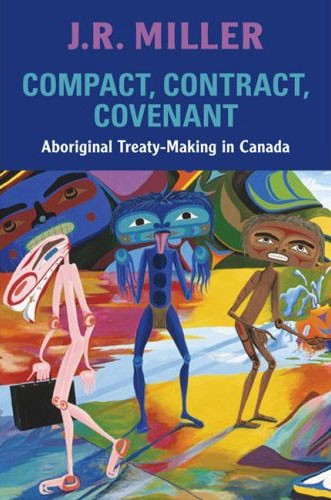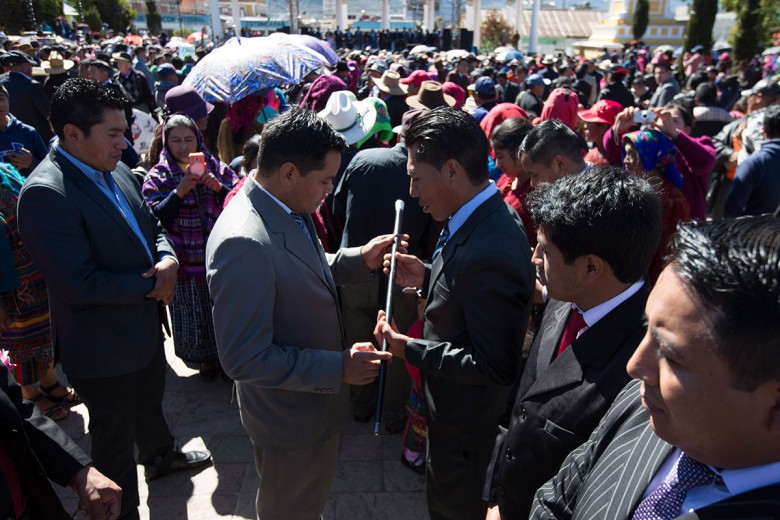
Compact, Contract, Covenant: Aboriginal Treaty-Making in Canada
By J.R. Miller
University of Toronto Press, 2009
In Compact, Contract, Covenant, J. R. Miller provides the first comprehensive history of treaty-making in Canada. From the earliest days of trading partnerships and military alliances to modern comprehensive land claims, Miller explores the complex and shifting relations that guided the formation of treaties. Although he is primarily an archival historian, Miller draws upon substantial research on oral histories to capably address not only Crown motivations but also Aboriginal intentions in forging covenants with the newcomers.
While treaties are typically viewed simply as a means of dispossessing Aboriginal peoples of their lands, Miller offers a much more nuanced look at the complex history of convergent and competing interests that the treaties embody. Dispossessing Aboriginal peoples of their lands certainly represents a core objective of Crown negotiators for the last couple of centuries, but Miller reminds readers that there was a long and rich history of treaty-making with Aboriginal nations that preceded land transfers. For more than a century and a half, Aboriginal peoples integrated Europeans into their existing kinship system through trade compacts and military alliances. This history of relations between peoples, too often forgotten in settler society, forms the basis of how many Aboriginal peoples understand treaties.
Miller traces the centuries-long transformation of treaty-making from these early systems of Aboriginal alliance towards the formalized terms of British law. This transformation produced ever-increasing discord between Crown and Aboriginal understandings of treaty; Miller’s history provides an excellent framework for understanding this conflicted legacy. Miller argues that treaties were vital to the construction of Canada, and frames his history of treaty-making as a Canadian one. This is a frame that we may want to question for its nationalist presumptions. First, however, it is worth reviewing the compelling historical trajectory that Miller traces.
In the early period, Europeans adapted to existing Aboriginal systems, following Aboriginal norms of ceremony in establishing trading relationships and forging agreements. Trade encounters were marked by formal welcomes, oratory, gift exchange and feasting, ritually renewing the bonds between peoples. Participants sacralized relationships through smoking a calumet and thus invoking the Great Spirit to spiritually bind them together. While Europeans desired furs and First Nations wanted European goods, these were not simply economic exchanges.
These commercial compacts formed the basis of peace and friendship treaties. In fact, for First Nations the two were integrally connected. The French, working through Aboriginal systems without formal written agreements, were first among the colonial powers to seriously delve into the realm of military alliances. The British, in contrast, began in 1707 to use a more formal system of peace and friendship treaties. The introduction of British modes of textually encoding agreements began to transform the processes of forging cultural connections among allies.
Following France’s abandonment of New France in the Treaty of Paris, the British King issued the Royal Proclamation of 1763 to quell dissent among France’s former Aboriginal allies. Seeking to address some of the chief Aboriginal grievances regarding settlement and unscrupulous land deals, the Royal Proclamation recognized Aboriginal title and created a protocol for acquiring Native lands.
It was only after the Proclamation that territorial treaty-making emerged as the governing paradigm. However, if the intent of the Proclamation found warm reception among Aboriginal leaders, its implementation was much less popular. Crown representatives often failed to uphold the particular requirements of the Proclamation in negotiations. Nonetheless, the negotiations continued to respect Aboriginal customary protocols of treaty-making, including sharing the pipe and practices of gift-giving.
Thereafter, there was an increasing rift between British and Aboriginal understandings of the relationship established through treaties. For the British, treaties were documents of land cession. The 12 treaties signed prior to the War of 1812 provided access to Mississauga-controlled lands along the Great Lakes while recognizing Aboriginal peoples’ continuing rights to land use. First Nations’ increasing insistence on having particular lands set aside for traditional practices, as well as assistance fighting settler encroachments, highlighted their increasing problems with settler disrespect of Aboriginal lands and traditional practices.
As the costs and responsibilities associated with treaty-making increasingly shifted from Britain to the colony, this disrespect increasingly came to characterize the colonial administration’s dealings with Aboriginal peoples. Subsequent to the War of 1812, policy shifted to bring about not only the dispossession of Aboriginal peoples but also an erasure of their sense of distinct identity. There was an increased focus on “civilizing” (assimilating) the Indians. By the mid-19th century, the government of Upper Canada was consistently acting in violation of the terms of the Proclamation, issuing access to resources over which it had not yet treatied. In the Maritimes, Quebec, and British Columbia the government failed almost entirely to treaty for land.
In the northern Great Lakes area and the Western Prairies, strong Prairie and Woodlands First Nations insisted on treaties before settlement or development, interfering with surveyors and prospectors on their lands. These nations looked to treaties as a way to protect their peoples through the economic transition to a new way of life. Their defence of their title led to the creation of the Robinson Treaties, and the first seven numbered treaties.
Crown Treaty Commissioners again treatied in accordance with First Nations protocols, entering kin relations with the pipe ceremony that sacralized all the words spoken in their discussion under the Creator. However, Miller makes it clear that the Commissioners likely possessed little understanding of the significance of ceremony, contributing to substantial differences in the encoding of the spirit and intent of treaties in First Nations oral histories and the Crown’s written documents. While the texts of these treaties typically cede vast swaths of land, establish reserves, initiate annuities and recognize hunting and fishing rights, the oral history of nations such as the Blackfoot indicate that treaties were understood as agreements to share, not surrender, the land.
The numbered northern treaties (8 through 11, plus the northern adhesions to Treaty Five) were signed between 1899 and 1921 and covered the present-day northern portions of Alberta, Saskatchewan, Manitoba, Ontario and northeastern B.C., as well as western Northwest Territories and eastern Yukon. This was the final stage of historic treaty-making. While northern First Nations had been demanding treaties for a substantial period of time, it was only with the recognition of hydro, mining, and oil potential in the north that the government sought to treaty. These treaty expeditions were hurried and poorly executed, resulting in the exclusion of some bands, most notably the Lubicon Lake Cree. The crude economic calculus guiding the process further excluded prime sites for economic development, such as potential hydro sites, from reserve selection.
Nonetheless, the treaties continued to be conducted with gestures to the elaborate ceremonies established during the fur trade, although in the harried context of these agreements it was largely reduced to a feast following the conclusion of the agreement. Knowledgeable about past problems with treaty implementation, northern First Nations sought greater assurance of the protection of their rights under treaty, soliciting extensive oral promises that went unrecorded in the text. Thus, the northern treaties often demonstrate the greatest discord between the written text and oral record.
From 1923 until the James Bay Agreement in the 1970s, the government abstained from treaty activities. During the 1970s, as the government sought to further extend resource exploitation onto untreatied lands, First Nations again pressed their rights, forcing the initiation of modern treaty-making. Bolstered by a spate of Supreme Court decisions recognizing the validity of Aboriginal historic claims and necessity of addressing them, Aboriginal peoples forced the government to develop a new federal comprehensive claims process.
Miller notes that modern treaties represent a significant departure from the model of historic treaty negotiations. Backed by advances in legal recognition, and the constitutionalization of Aboriginal rights, the negotiations are complex and require years to complete. The final agreements are hundreds of pages long and marked by dense legal jargon, and Aboriginal protocol is absent as a shared ceremony.
While Miller acknowledges how modern claims legal proceduralism is effacing traditional Aboriginal forms of treaty-making, he adopts an ambiguous position with regard to these modern treaties. Miller recognizes the criticisms of extinguishment policy, of how modern treaties entail Aboriginal peoples abandoning their broad but undefined traditional rights in favour of a limited, clearly defined subset of those rights, plus cash compensation. But he simply states “[w]hether or not this formula will prove satisfying and effective remains to be seen” (266-267).
Politically, Miller presents a treaty federalist position. He argues that Canadians need to recognize the validity of Aboriginal rights and claims to land, while he castigates some contemporary Aboriginal claims to distinct nationhood and sovereignty as based on what he perceives as specious arguments about the nature of historical agreements. The idea of “Canada” itself is not up for negotiation.
The way in which Miller frames his history within the assumptions of Canadian nationalism, as “a history of treaty-making in Canada” serves to naturalize the idea of Canada historically, even as it disrupts the conventional terms of Canadian history in its insistence on the centrality of treaty federation in constituting a European claim to share this land mass.
Nonetheless, Miller’s history effectively highlights the oft forgotten or obscured histories of mutuality between Aboriginal and European peoples. It is an important book, as it documents the necessity of understanding treaties as two-party agreements with ongoing political implications. To understand treaties simply as tools of dispossession silences Aboriginal histories and traditions of treaty-making, and discounts any political strategy that would see adherence to treaty claims as an effective means of addressing historical grievances and unmet responsibilities. Where Miller is most powerful and most provocative is in his reminder of the ways in which early treaties were forged through Aboriginal traditions, inviting newcomers into kinship relations with First Nations.






